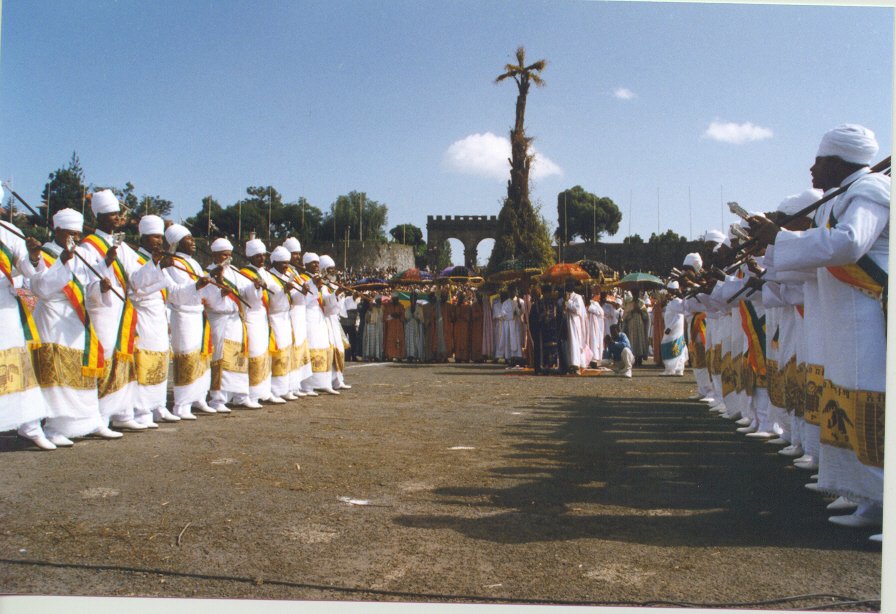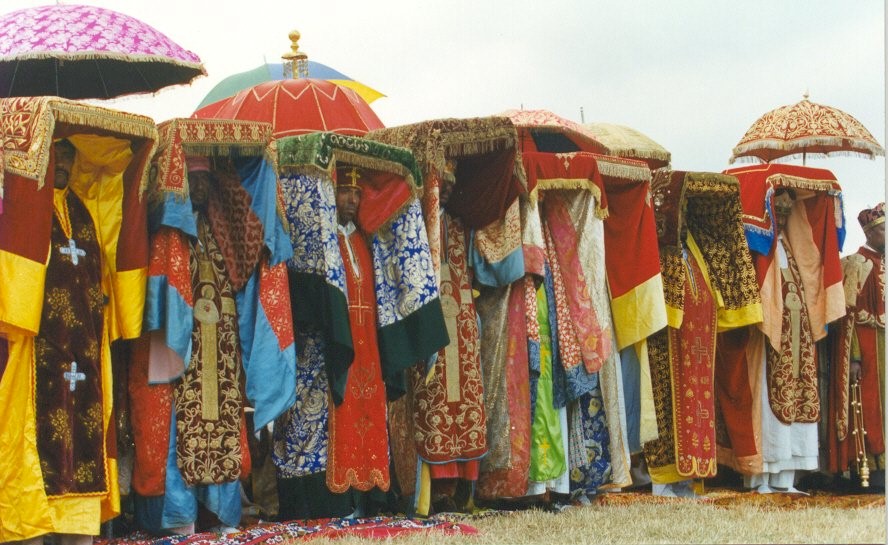|
|
|
Amhara regional state is one of the Country's richest region for cultural heritage,which is manifested by the day to day activities of its Amharic, Oromogna,Agewgna (Awi), Kimant, and Kamyr speakers. Hence, there exists a bounty of exotic costumes, colorful ceremonies & celebrations, arts, crafts, music and dances of each ethnic group with distinct tradition and fascinating character.
Language
As it's already mentioned in the introduction of the region, the main language spoken in the region is Amharic (Amhara - Name given the people who speak Amharic).It's the official language for both the regional state and the country. Amharic has its own script is the familly of the Semetic languages. Other languages spoken in the region include, Oromogna, Agewgna( Awi),Agew (Kamyr), and Kimant. In addition to this, there is no wondar for some one to hear Tigrigna from Few people, whose origin is from Tigray region or who used to stay with them.
Marriage
Marraige in this region is mainly based on the religion and the custum of each ethnic group. but usually there are common practices in different ethnic groups. for instance, in olden times, it was the parents of the couples who used to choose the husband or the wife to their children and arrange the wedding. The parents of the bridegroom are supposed to pay a dowry to the parents of the bride. Unfortunately, the children were forced to marry in their early ages with out knowing whom they will marry untill the wedding day.
These days it's keeping on changing especially, in towns and among people who attended the modern education though it's practiced in the rural areas.Even now, relationships between among modern young men and women may need to be conducted in secret, until they are ready for marriage. Sex appears to be a taboo subject. Normally women's virginity is used to be highly valued, with the whole family being shamed if she is not a virgin at marriage.The wedding cermonies, and tradit ional dances (Eskista) are very fascinating and long lasting in the memories of both local and international visitors.
Food
| As the most parts of Ethiopia,the main staple food in the region is Injera and
Wat. Injera is a flat pancake-like thin broad-bread made of a staple grain called Teff which only
grows in Ethiopia ( and largely produced in this region). Teff is made into a dough which is
allowed to ferment before it is cooked into Injera.This is then eaten with various kinds of stew
called Wot (soup). Wot can be made of meat, vegetables,peas, lentils, etc., and can be very highly
spiced. Doro Wot, a stew of chicken marinated chili,spices, butter and hardboiled eggs, which
is eaten with Injera.
A formal meal begins with the washing of hands. A decorative metal or earth ware jug is brought to the table and water is poured over the guest's out stretched hands into a small basin. A short prayer or grace usually follows. |
 |
Drinks
The two main traditional beverages are Tella (local Beer), Tej (local Mead) and Arek'i (native distilled liquor).Both Tella and Arek'i are made from more or less similar ingredients like sorghum, finger millet, barely and wheat sprout and seasoned with the dried and traditional leaves and twigs of Gesho (used as hops) plants. Tej (mead) is made of a mixture of honey and water, which is flavored with gesho plant twigs and leaves and allowed to ferment. Tej has a higher content of alcohol than Tella. Arek'i is the strongest of all and should be drunk in quantities.
Coffee is also widely drunk in in the region like other parts of Ethiopia and it is treated with the respect properly due it. The honor bestowed upon coffee cermony is some thing which is very much appreciated than the actual drink. A typical delicious Ethiopian meal is followed by an elaborate coffee ceremony. While the guests are replete after their Injera and Wot, a woman of the household quietly starts the ritual. It 's also served in bars and restuarants in towns.
Clothing
Clothing in Amhara Regional State is the typical manifistation of the northern and north western tradional clothing. It's also similar to most cities and towns of the country.Women traditionally wear white dresses, while men wear white tunics over riding pants. This is usually worn on special occasions. Heavy cloth is worn for warmth; it is called a Gabby ( Sort of blanketlocally woven from cotton). Light gauze - like cloth is worn for dress occasions; it is called a Netella. Netella usually has a very colorful border on it, which is also found near the bottom hem of the women's dress, However, a wide variety of clothing can be seen in the region especially, in towns ranging from loin clothes to the latest fashion.
Festivals
The most important Muslim festival is Ramadan, which takes place on the ninth month of the lunar year, according to the Islamic calendar. Ramadan marks the end of a month long fast, which services to remind people of how the Koran was revealed to the Prophet Mohammed. The period of feasting and celebration after the fast is known as Id-al-fitir.
Enkutatash ( Ethiopian New Year)
This festival is celebrated on Meskerem 01 (11 September) every year. It celebrates both the Ethiopian New Year and the Feast of John the Baptist at the end of the long rains in Spring, when most of the region become covered in wild flowers , Locally called "Adey Abeba". Children dressed in new clothes dance through the villages, distributing garlands and tiny paintings. In the evening every house lights a bonfire and there is singing and dancing.On that special day people excahnge variety of gifts and their good wishes for the upcoming new year.
Maskal- Finding of The True Cross
| Maskal is celebrated on Meskerem 17 (27 September) every year. According to Legend has it that the
cross upon which Christ was crucified was discovered in the year 326 by Empress Helen, Mother of
Constantine the Great. Unable to find the Holy Sepulchre, she prayed for help and was directed by
the smoke of an incense burner to where the cross was buried.
In the Middle Ages, the Patriarch of Alexandria gave the Ethiopian Emperor Dawit half of the True Cross in retum for the protection afforded to the Coptic Christians. A fragment of the True Cross is reputed to be held at the Gishen Mariam monastery which is about 70 kilometres to the northwest of Dessie. |
 |
Genna (Ethiopian Christmas)
Genna is Celebrated on Tahsas 29 (January 7th) and preceded by a fast of 40 days.This is the celebration of christians by recalling the birth day of Jesus Christ about whom shepherds on Judean hills witnessing the celestial song of angels as they pronounced the Long Expected One had come. On the eve of Christmas people gather in churches for mass that lasts about 3 hours. The clergy and "Debtera"(scholars versed in liturgy and music of the church) lift theirvoices in hymns and chant just as it has been for over a thousand years when Ethiopia accepted Christianity. As the cermonies in the church is over, the fast is broken so the clergy and crowd alike disperse to their homes to feast. Food and drink is plentiful, with many homes preparing special meals that are characteristic to all big festivities highlighted on the Ethiopian calendar.
During this special day, people do play Genna (traditional Ethiopian hockey), which owes its name to the fact that it was played at Genna (Ethiopian name for Christmas). And it is around this time that the game was, and still is, normally played. Boys and grown-up men (but the boys were usually the first to start, a week or so before Christmas) began by assembling in two rival, or opposing groups. They would do so in an open stretch of land, in many cases the local market place.
Timket (Epighany)
 |
Timkat is the greatest Orthodox festival celebrated on Tir 11(January 18 or19).It is the
commemoration of the baptism of Jesus Christ and marked by the procession of the tabots (the replicas of
the Ark of the Covenant, the original of which is said to be in the chapel at Axum). Concealed by
an ornamental cloth, it is taken to a tent, close to a consecrated pool or stream, accompanied by
much ringing of bells, blowing of trumpets and the burning of incense.
At dawn the priest extinguishes a candle burning on a pole set in a nearby river using a ceremonial cross. Some of the congregation leap into the river. finally, People bathe in the lakes or rivers and splash water over onlookers.The Tabots are then taken back to the Churches in procession, accompanied by horsemen, while the festivities continue by traditional dances and praises of God the elderly, youngsters and children. |
Fasika( Ethiopian Easter)
Fasika( Ethiopian Easter) is a celebration of the resurrection of Christ after a 55 day fasting and prayers. It's one of the greatest holidays in the calendar of Christian Ethiopian churches. For christians,the Easter message is about hope and victory over death, for it recalls that Christ rose from the dead on the third day after his crucifixion. Easter symbolizes the love of God and the promise that man's soul is immortal.
Devout followers of the Ethiopian Orthodox Church offer daily prayers at the Church and do not eat until 3 PM, except Saturday and Sunday when prayers are conducted early in the morning. Easter always takes place in glorious weather and enormous effort put into making the occasion memorable. people do prepare food and drinks like Tella(local beer),Tej (mead) is local made drink made of a mixture of honey and water, which is flavored with Gesho plant twigs and leaves and allowed to ferment. On fasika (Easter) it is hard to find people, who don't Slaughter Chicken, oxen, or sheep ( believed by orthodox christians as a representation of Jesus christ, who gave his life for his people), provided they have enough money to buy.
